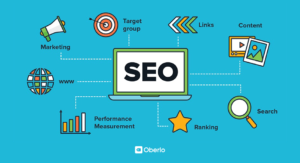How to Optimize Your Website for Search Engine Optimization (SEO)
A search engine has two primary functions: crawling and rendering. These processes are responsible for a website’s visibility on SERP. For more information, click the https://www.rankboss.com/ provided to proceed.
Webpages, including articles, are what a search engine like Google stores in its index. It analyzes each one to understand its topics and keywords, so that it can display relevant results when someone searches.

Keywords are the building blocks of a website’s optimization, and they’re one of the most important metrics to track. By understanding what words and phrases users are typing into search engines, marketers can create content that aligns with their needs at every stage of the funnel. This is key to increasing organic traffic and improving the overall effectiveness of a website.
Developing and tracking keywords is the foundation of any successful SEO campaign. Whether you’re trying to boost your ranking on the first page of Google or attract more visitors to your site, you need the right keywords to do so. A few missteps with keywords can have serious consequences for your digital marketing efforts. To avoid making these mistakes, you should follow these best practices.
In the world of SEO, the word “keyword” is used interchangeably with “keyword phrase” or “search query.” However, most people outside the industry don’t think about them in the same way. For example, many people might not consider “mens leather jacket” a keyword, even though it is searched more times per month than “pizza dough.” This confusion is partly due to the fact that Google’s Keyword Planner tool used to group together terms that were searched closely enough to be considered synonymous.
A good keyword is one that reflects the intent of a user’s search. For example, if someone searches for “lead generation,” it indicates that they are interested in generating leads and are at the top of the conversion funnel. On the other hand, if a person searches for “Mailchimp guides,” they are likely already familiar with the product and at the bottom of the funnel.
By understanding the intent of each keyword, marketers can optimize their content accordingly. For instance, if a website ranks well for the keyword “lead generation,” it should include content that provides valuable information about how to generate leads. This content should be useful to the audience and help them convert to customers. In addition, marketers can use the search term to gauge the effectiveness of their current strategy by evaluating the results. For example, a low search engine ranking might prompt them to retool their content or approach social media messaging differently.
Content is a key component of any SEO strategy. It helps search engines find and rank websites for keywords that are relevant to users. It can be text, images, video, or infographics. But it is most often found on website pages, as part of an article or blog post. The best SEO content is high quality, useful to customers and positioned well on the web page. It also incorporates a number of different SEO techniques, including using keywords in title tags, meta descriptions, and alt text.
Consistently creating SEO content can help build trust and authority with consumers, which in turn leads to conversions. Research shows that B2B companies with an effective content marketing strategy generate three times more qualified leads than those without one. This is because consumers rely on brands to provide valuable, informative content to make purchasing decisions.
A good SEO content creation strategy can also give you more indexed pages on your website. This is important because Google considers on-site time as a ranking factor when determining how well a site ranks in a search result. It also enables you to target a specific audience and position yourself as an expert in your industry.
One common piece of SEO lore is that longer articles tend to rank better than shorter ones. However, this is not always the case. There are many factors that influence the quality of your SEO content, and the most important factor is its relevance to a user’s query. For example, a well-researched and helpful blog post about the best way to install a home alarm system will likely rank higher than an article about the latest celebrity gossip.
Getting clear on your keyword and searcher intent is also critical to creating effective SEO content. Once you know what type of user you are trying to attract, you can tailor your content to match their needs and expectations. This will make them more likely to take the action you want, such as downloading a whitepaper or purchasing a product.
Finally, consistent SEO content can establish your brand as a thought leader in your industry. For instance, a blog post that offers advice on how to avoid a scam will likely rank highly in search results, as will an infographic that highlights the latest data on the industry. These pieces of content can also help your consumers solve problems, which makes them more likely to return to your site for future guidance.
Link building is a major player in the world of SEO, and it can boost organic search engine traffic for your business. This practice involves acquiring hyperlinks from other websites that point back to your website. These links are a crucial part of search engine optimization and are especially important for businesses in competitive niches. However, it’s also important to remember that link building isn’t a magic bullet and should be combined with other rich SEO strategies, such as on-page SEO and great content.
In addition to increasing your organic search visibility, link building is also a great way to increase brand awareness and build trust in your niche. It can help you establish yourself as a leading expert in your field, and it will help potential customers find the information they need. Moreover, it will improve your website’s credibility and reputation, and it can lead to more sales and leads. Moreover, the more reputable and trusted sites you have linking back to your site, the higher your SEO ranking will be.
The best way to build quality backlinks is to create valuable content that people want to link to. This means creating content that is unique, informative, and provides value to the user. It’s also helpful to use tools like Broken Link Builder or Links In Use, which will help you find and reclaim broken links on other sites. Using these tools will help you identify opportunities to get links and will save you time.
While some SEOs may use outdated tactics, this is not a good idea for long-term SEO success. Today, search engines place a greater emphasis on quality and relevance, so low-quality content will only hurt your SEO efforts. In addition, low-quality links will likely be removed by Google, which can negatively impact your search engine rankings.
There are many methods for creating high-quality links, including guest blogging and blog comments. Creating valuable content is the most effective way to earn links, but it’s also important to promote your content. For example, if you write an article about a topic that’s currently trending, you can promote it to attract more links. You can also use social media to promote your content.
Analytics is a powerful tool that can help SEOs monitor, measure, and analyze website traffic, user behavior, and conversions. It also helps them identify opportunities for improvement and make data-driven decisions to optimize their SEO campaigns. It is important to set up a robust system for tracking and recording website metrics, and then regularly evaluate and adjust these metrics to improve performance.
One of the most important metrics for evaluating SEO success is organic search traffic, which represents visitors who reach a website through natural search results. A high organic search traffic rate indicates that your SEO strategy is working. It is also important to look at user behavior metrics such as bounce rates and time on site. These metrics indicate whether your content is engaging and relevant to users’ needs and interests.
Another important metric is the conversion rate, which measures how many visitors to your website take the action you want them to take. For example, if a visitor buys something from your website or fills out a form, this is considered a conversion. A high conversion rate shows that your website is meeting users’ needs and generating revenue.
Backlink analysis is a valuable tool in SEO analytics, as it allows you to assess the quality and relevance of links that point to your website. It also enables you to compare your competitors’ link profiles and determine how they are performing in the SERPs. By conducting this analysis, you can improve your website’s ranking and boost its online visibility.
Social media analytics is a valuable tool in SEO analytics, because it allows you to track the number of likes, shares, and retweets your posts receive on different social media platforms. This information can help you determine which types of content resonate with your audience and how effective your social media marketing efforts are.
A crucial part of SEO analytics is goal tracking, which involves setting specific objectives and tracking the progress towards those goals. This can be a difficult task, especially for smaller agencies that have multiple clients. However, there are tools available that can help you automate this process and create reports for your clients in a professional way. These tools can save you a lot of time and effort, and some of them even have the capability to create custom dashboards for each client.
